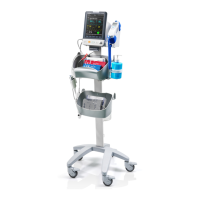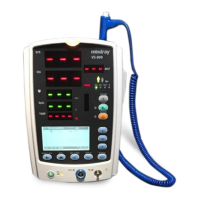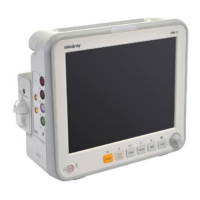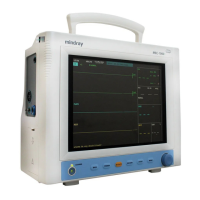VS 8/VS 8A Vital Signs Monitor Operator’s Manual 16 - 25
If you need to change network settings, select beside the desired wireless network.
Selecting deletes the wireless network.
16.15.5 Managing Certifications
You can delete certifications from the monitor, or import certifications from the USB
memory device. To do so, follow this procedure:
1. Select the Main Menu quick key → from the System column select Maintenance
→ input the required password → select .
2. Select the Network Setup tab → WLAN tab.
3. Select Certificate Management button from the bottom left corner of the dialog.
◆ From the Local tab, select certifications you want to delete from the
monitor, and then select Delete.
◆ From the USB Drive tab, select certifications you want to import from the
USB memory device, and then select Import.
16.15.6 Enabling Selecting a CMS
To enable selecting a CMS, follow this procedure:
1. Select the Main Menu quick key → from the System column select Maintenance
→ input the required password → select .
2. Select the Network Setup tab → Transfer Setup tab.
3. Switch on Select CMS.
16.15.7 Adding CMSs
You can add up to 30 central monitoring systems (CMS) for your monitor. To add CMSs,
follow this procedure:
1. Select the Main Menu quick key → from the System column select Maintenance
→ input the required password → select .
2. Select the Network Setup tab → Transfer Setup tab.
3. Set Send Data to Central Station.
4. Select Add Central Station, and then input the CMS name and IP address of this
department.
16.15.8 Using the ADT Gateway
The ADT (admit-discharge-transfer) gateway is normally deployed in the eGateway. You
can obtain patient information from the hospital ADT server through the ADT gateway.
To configure the ADT gateway, follow this procedure:
1. Select the Main Menu quick key → from the System column select Maintenance
→ input the required password → select .
16 - 26 VS 8/VS 8A Vital Signs Monitor Operator’s Manual
2. Select the Network Setup tab → Transfer Setup tab.
3. Select Server Address to input the host name or IP address of the ADT gateway.
4. Select Port to input the port of the ADT gateway.
ADT Query is switched off by default. You can load patient information to the monitor
from the ADT server only when this function is enabled.
After configuring the ADT gateway, select Network Test to verify that the ADT server is
properly connected.
16.15.9 Sending Realtime Data, Waveforms and Alarms via HL7
Protocol
You can send the realtime data, waveforms, and alarms from the monitor to the hospital
servers via HL7 protocol. To do so, follow this procedure:
1. Select the Main Menu quick key → from the System column select Maintenance
→ input the required password → select .
2. Select the Network Setup tab → Transfer Setup tab.
3. Set Send Data to HL7.
4. From the Data + Waveforms area, select Server Address to input the name or IP
address for the server receiving the realtime data and waveform. Set Port.
5. Switch on Send Data and Send Waveforms, as needed. Set Data Interval.
6. From the Alarms area, select Server Address to input the name or IP address for
the server receiving the alarm data. Set Port.
7. Switch on Send Alarms as needed.
This page also displays the server connection status.
• Licenses are required for sending realtime data, waveforms, and alarms via
HL7. For more information on checking the licenses, see 3.9.6 Checking
Software Licenses.
16.15.10Setting Multicast Parameters
Multicast helps device discovery between monitors and other devices on the network.
Devices in the same multicast group can be mutually discovered.
To set multicast parameters, follow this procedure:
1. Select the Main Menu quick key → from the System column select Maintenance
→ input the required password → select .
2. Select the Network Setup tab → Device Discover tab.
3. Set Multicast TTL.
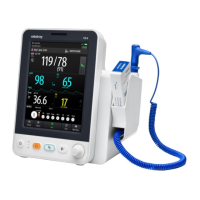
